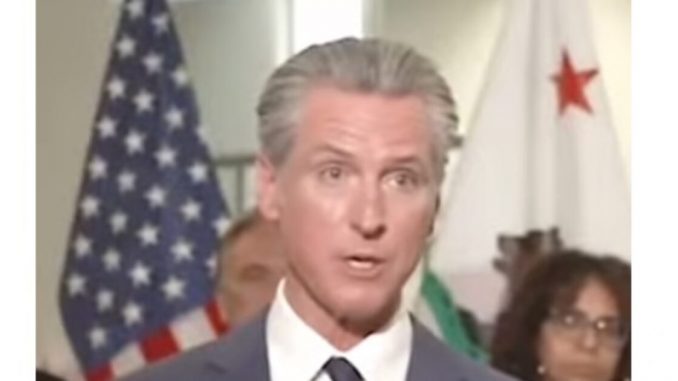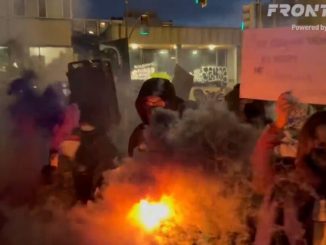
Governor Gavin Newsom said he was “sick and disgusted” that ICE was arresting illegals outside his presser on Thursday. – via Newsom YouTube Channel
| Published August 20, 2025
California Governor Gavin Newsom’s press team got bodied again on X after trying to defend California’s sanctuary state policies and credit the Trump Administration for an illegal alien killing three Americans.
A recent incident involving an illegal alien who obtained a California driver’s license and later caused a fatal crash in Florida has sparked a public dispute between California Governor Gavin Newsom’s office and the Department of Homeland Security (DHS).
The Incident
The driver, Harjinder Singh, was involved in a tragic accident on Florida’s Turnpike, resulting in the deaths of three individuals. Singh had crossed into the U.S. in 2018 and was granted a work permit by the Biden administration in June 2021, after a previous application was denied by the Trump administration in 2020. Additionally, he obtained a commercial driver’s license (CDL) in California, a state known for its sanctuary policies.
The core of the controversy revolves around Harjinder Singh, an individual who became involved in a tragic accident on Florida’s Turnpike, resulting in the deaths of three people. This event drew national attention not only because of its tragic outcome but also because of the circumstances surrounding Singh’s legal status and driving privileges.
-
Immigration Background
-
Singh initially entered the United States in 2018.
-
His initial application for legal status was denied under the Trump administration in 2020.
-
Later, under the Biden administration, he was granted a work permit in June 2021. This timing became a focal point in the political dispute that followed.
-
-
Driver’s License and CDL
-
Singh obtained a commercial driver’s license (CDL) in California, a state recognized for its sanctuary policies that can make immigration enforcement more complex.
-
California law typically prohibits undocumented individuals from obtaining a driver’s license, but Singh was still able to secure one. This raised questions about state-level compliance with immigration regulations.
-
-
Fatal Accident
-
Singh’s actions behind the wheel led to a fatal crash on Florida’s Turnpike, tragically killing three people.
-
The incident triggered a broader discussion about cross-state enforcement of immigration and licensing laws, and how gaps in policy can have real-world consequences.
-
The Dispute
Following the tragic accident involving Harjinder Singh, a public disagreement erupted between California Governor Gavin Newsom’s office and the Department of Homeland Security (DHS). The dispute centers on who is responsible for the policies that allowed Singh to obtain legal driving credentials despite his immigration status.
-
Newsom’s Press Office Statement
-
The governor’s office issued a public statement attempting to shift blame to the Trump administration, highlighting that Singh had initially entered the U.S. during that period.
-
They emphasized that the previous administration had denied his legal status in 2020, suggesting that any fault lay with federal immigration policies at that time.
-
However, in making this argument, Newsom’s office inadvertently highlighted California’s role, noting that state law prohibits undocumented individuals from obtaining driver’s licenses—yet Singh had still obtained a CDL. This contradicted California law and opened the administration to criticism.
-
-
DHS Response
-
DHS Assistant Secretary Tricia McLaughlin publicly challenged Newsom’s office, asserting that the statement was misleading to the public.
-
McLaughlin pointed out that Singh’s work permit had been issued under the Biden administration, not the Trump administration, making the blame-shifting politically inaccurate.
-
She further stressed that California granted Singh a commercial driver’s license despite state law prohibitions, placing responsibility squarely on state-level policies.
-
-
Underlying Policy Tensions
-
This exchange underscores the friction between federal immigration enforcement and state sanctuary policies.
-
While federal authorities issue work permits and enforce immigration laws, states like California maintain policies that protect undocumented individuals, sometimes creating legal and practical conflicts.
-
The public argument highlights the challenges in accountability, especially when federal and state jurisdictions interact in complex ways.
-
 Implications
Implications
The Harjinder Singh incident highlights several key implications for immigration policy, public safety, and state-federal relations:
-
Policy Contradictions Between Federal and State Levels
-
Singh was able to obtain a work permit under the Biden administration while simultaneously securing a California commercial driver’s license despite state laws prohibiting undocumented individuals from doing so.
-
This underscores the tension between federal immigration enforcement and state sanctuary policies, revealing gaps that can have serious real-world consequences.
-
-
Public Safety Concerns
-
The fatal crash that killed three people raises questions about how states verify driving qualifications and immigration status before issuing licenses.
-
It also highlights the risk of tragic outcomes when coordination between federal and state agencies is insufficient.
-
-
Political Accountability and Messaging
-
The dispute between Newsom’s office and DHS reflects how political narratives can clash with facts on the ground.
-
Misalignment between political messaging and actual policy responsibilities can erode public trust in both state and federal agencies.
-
-
Legal and Regulatory Oversight
-
The incident could lead to closer scrutiny of licensing practices in sanctuary states, prompting potential reforms in how driver eligibility is verified.
-
It may also encourage federal-state cooperation to ensure that legal work authorization and licensing processes are aligned, minimizing future conflicts.
-
-
Broader Immigration Debate
-
The case serves as a flashpoint in the ongoing debate over immigration, sanctuary policies, and border security.
-
It illustrates how individual incidents can amplify national policy debates, influencing both public perception and legislative action.
-
 Overall Takeaway:
Overall Takeaway:
The tragic crash involving Harjinder Singh serves as a stark reminder of the complex interplay between federal immigration policy and state-level enforcement, particularly in sanctuary states like California. While California issued Singh a commercial driver’s license in apparent violation of its own laws, the Biden administration had also authorized his work permit—creating a scenario where accountability became blurred.
The public dispute between Governor Newsom’s press office and DHS underscores the dangers of political finger-pointing, especially when lives have been lost. DHS’s response highlighted the importance of accurate public communication and policy compliance, emphasizing that misrepresenting facts to shift blame can erode public trust.
Ultimately, the incident exposes gaps in immigration, licensing, and public safety oversight, suggesting the need for stronger coordination between state and federal authorities. It also illustrates how individual tragedies can spark national debate over policy, accountability, and the consequences of conflicting regulations.





Be the first to comment